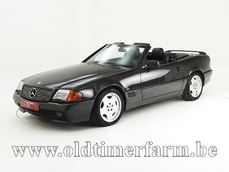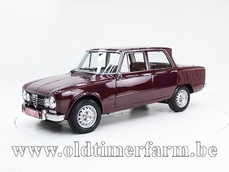Mercedes-Benz 500SL r129 SL + Hardtop '89 1989
General description :
Twin-exhaust Dutch car since 1998 Both a tribute to the past and a pioneer in modern Mercedes-Benz design Most powerful engine in its series The Mercedes-Benz R129 was a series of luxury coupes that succeeded the revered R107 series. This new series also came with a lot of superstar glamour. It came in a wide range of various engines, and was produced for thirteen years on end, from 1989 to 2001. Like its ancestors, the Gullwing, the Pagoda, and the R107, the R129 quickly gained the cult status it deserved. In 1989, discontinued the R107 series and decided to succeed it by a new series called the R129. However, this replacement was not the true end of the R107 as it still is a coveted classic nowadays. The R129 is an equally sporty, if not sportier compared to its predecessors, and Mercedes-Benz’ characteristics were embodied in it as well: the design is contemporary, and it came with innovative technologies. Just some of these technologies were an electrified automatic convertible system, a safety-enhancing automatically deploying rollover bar in the event of an accident, even a very innovative driving position system was installed in the seats. Besides that, the R129 was available in various engine finishes, as it had been this way before. People could change in a range of engines that went from a 12-valve six-cylinder engine to a 48-valve V12. Though all engines had their own charm and all of them were impressively performant. The angulated design typifies Mercedes-Benz’ nineties style which was also retained after facelifts in 1995 and 1998. However, these facelifts brought some visible distinctions, the most noticeable being the cases of the turn signals, which were no longer orange but coloured with the transparent headlights. From 1998, each cylinder was powered with two spark plugs in order to achieve an even smoother and more efficient combustion with maximum efficiency. The R129 is a tribute, and a continuation of the past of Mercedes-Benz' classy and powerful coupes. At the same time, its new technology shows preparedness for the future. Mercedes 500 SL The 500 SL was released as being the flagship of the R129 series that was first shown to the world in 1989. Its powertrain must be the most noteworthy as this car is powered by a 5.0L V8 that makes the car able to accelerate from 0 to 100 kilometres per hour (0-60 mph) in only six seconds. Pumping the gas pedal to the maximum makes it speed up to 250 kilometres per hour (155 mph) in its fourth - highest - gear. This series’ 500 SL will be a true investment that proves to be both functional and profitable. Its predecessors have their value been skyrocketing in the past years. Time will tell how long it will last until this R129 also increases in value. Technical information: Body work Length (cm): 447 (176 inch) Width (cm): 181 (71 inch) Height (cm): 129 (51 inch) Wheelbase (cm): 252 (99 inch) Weight (kg): 1770 (3902 lbs) Mechanics Engine: 4973 cc V8 front-engine Valve gear: 32 Fuel system: Bosch KE5-Jetronic Gear box: 4-speed automatic Transmission: RWD Left-steered power: 322 hp (240 kW) at 5500 t/m torque: 450 Nm at 4000 t/m Top speed: 250 km/h (155 mph)
1989 Mercedes-Benz 500SL r129 SL + Hardtop '89 is listed for sale on ClassicDigest in Aalter by Oldtimerfarm for €23500.
Car Facts
Car type : Car Make : Mercedes-Benz Model : 500SL r129 Model Version : SL + Hardtop '89 Engine size : 0.0 Model Year : 1989 Location : Aalter Vehicle Registration : Undefined
23500 €
People who viewed this Mercedes-Benz 500SL r129 also viewed similar Mercedes-Benz listed at ClassicDigest
Other cars listed for sale by this dealer
About Mercedes-Benz
In the annals of automotive history, the journey of Mercedes-Benz is a tale that unfolds with the ingenuity of its founding pioneers. In the year 1886, Karl Benz crafted the Benz Patent Motorwagen, a creation that would go down in history as the world's inaugural automobile. Unbeknownst to him, this moment marked the genesis of what would evolve into the most illustrious premium car manufacturer globally. The financial underpinning of this pioneering venture, interestingly, was provided by Karl Benz's wife, Bertha Benz, demonstrating a remarkable partnership that would set the tone for Mercedes-Benz's legacy.A parallel narrative emerged not far away, as Daimler-Motoren-Gesellschaft, founded by Gottlieb Daimler and Wilhelm Maybach, entered the scene. In 1901, they unveiled their automobile under the now-famous moniker "Mercedes," meaning "godsend" in Spanish. This name was bestowed upon the car at the behest of Emil Jellinek's daughter, the distributor for Daimler-Motoren-Gesellschaft. The wheels of innovation were set in motion.
Fast forward to 1926, a pivotal year that witnessed the merger of Daimler with Benz & Cie., culminating in the birth of Daimler-Benz. The amalgamation saw the adoption of "Mercedes-Benz" as the distinguished trademark for their automobiles, fusing the legacies of two visionary entities into one.
Contrary to perceptions of conservatism, the trajectory of Daimler-Benz unfolds as a chronicle of industry firsts. From the introduction of the honeycomb radiator to the float carburetor, and the pioneering implementation of four-wheel brakes in 1924, Daimler-Benz consistently pushed the boundaries of automotive innovation. The diesel-powered Mercedes-Benz 260 D in 1936 marked the inception of diesel engines in passenger cars. The iconic Mercedes-Benz 300SL Gullwing made history as the first car with direct fuel injection, albeit the Gutbrod's tiny 2-stroke engine can claim precedence.
Safety innovations became a hallmark, with Béla Barényi's patented safety cell design in the "Ponton"-models in 1951, featuring front and rear crumple zones. The W116 450SEL 6.9 saw the introduction of the Anti-Lock Brake system (ABS), another pioneering safety feature. From the first production airbags and beyond, the legacy of "firsts" continued to be etched into the fabric of Daimler-Benz.
Over its centennial journey, Mercedes-Benz has not merely produced cars but has sculpted automotive icons. The SSKL, 710 SSK Trossi Roadster, 770K Grosser, 540K Spezial Roadster, 300SL Gullwing, w100 600 Pullman, w111 280SE 3.5 Flachkühler, w113 230SL Pagoda, w109 300 SEL 6.3, and w201 2.3-16 Cosworth stand testament to the brand's commitment to engineering excellence.
The roaring Silver Arrows, or "Silberpfeile," including the W 25, W 125, W154, W165, and W196, created a legacy of dominance on the racetrack. These machines were not merely cars; they were expressions of precision, speed, and an indomitable spirit that left their competitors in the dust.
As Mercedes-Benz marches into the future, it does so not just as an automaker but as a custodian of a legacy, a torchbearer of innovation, and a beacon of automotive excellence. The road ahead is sure to witness the continued fusion of cutting-edge technology, timeless design, and an unwavering commitment to setting new standards in the world of automobiles.
One luminary figure who left an indelible mark was Béla Barényi, often heralded as the "father of passive safety" for his pioneering work in safety engineering. His patented safety cell design, featuring front and rear crumple zones, became a hallmark of Mercedes-Benz's commitment to occupant safety, setting new standards that reverberated throughout the automotive world.
Moving through the chronicles, the collaborative genius of Wilhelm Maybach, alongside Gottlieb Daimler, laid the foundation for Daimler-Motoren-Gesellschaft. Their innovations not only birthed the first Mercedes but established a culture of relentless pursuit of technological excellence that remains integral to Mercedes-Benz's DNA.
In the post-merger era of 1926, Ferdinand Porsche emerged as a prominent figure within Mercedes-Benz. His work on the Mercedes-Benz S-Type, a supercharged race car, garnered acclaim and set the stage for a legacy that extended far beyond the marque. Porsche's impact would later extend to his eponymous company, but his influence at Mercedes-Benz during those formative years was pivotal.
As the 20th century progressed, the legendary Rudolf Uhlenhaut emerged as a key figure. Uhlenhaut, an accomplished engineer and the driving force behind the iconic Silver Arrows, played a crucial role in Mercedes-Benz's dominance in motorsports. His engineering prowess and attention to detail were instrumental in creating some of the most formidable racing cars of the era.
In the latter half of the century, figures like Bruno Sacco, the head of design at Mercedes-Benz from 1975 to 1999, left an indelible imprint on the brand's aesthetic identity. Sacco's design philosophy, characterized by clean lines and timeless elegance, shaped iconic models like the W126 S-Class and the W201 190E, solidifying Mercedes-Benz's reputation for luxury and sophistication.
The narrative would be incomplete without acknowledging the contributions of engineers like Hans Scherenberg, whose leadership in the 1970s ushered in a new era of technological innovation at Mercedes-Benz. Scherenberg's tenure saw the development of groundbreaking technologies, including the Anti-Lock Brake system (ABS) and the introduction of airbags in production cars.

























